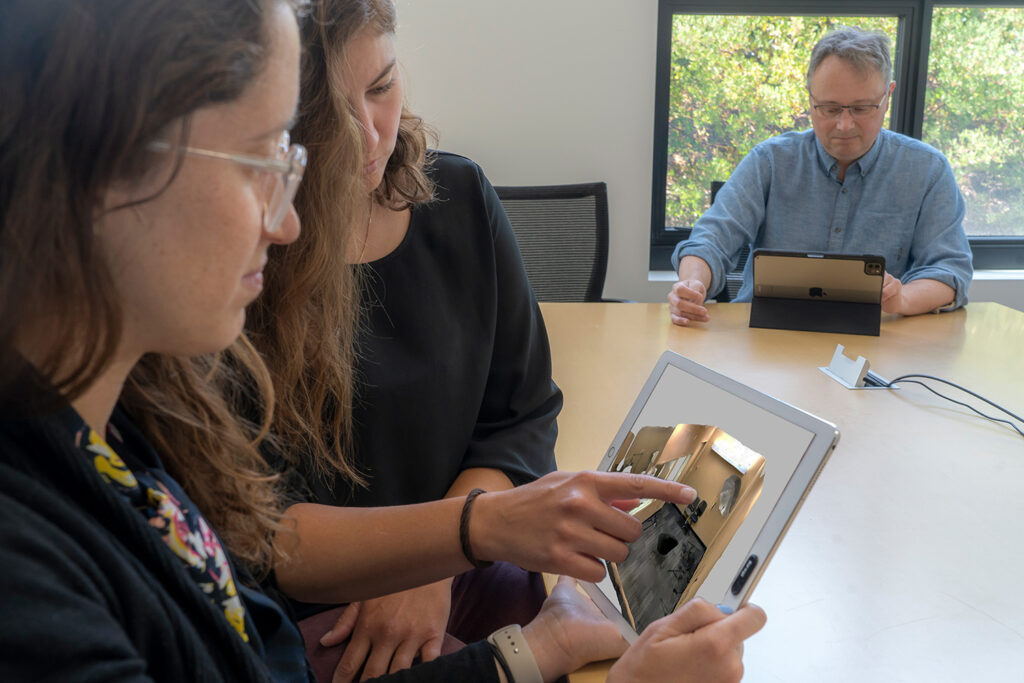Students build augmented reality experiences with devices from iPads for Learning program
The program explores how iPads can impact teaching, learning, and research and allowed journalism students to explore the intersection of extended reality and journalism.
The immersive space of virtual reality, cinematic VR, and augmented reality is journalism’s newest and most exciting reporting and storytelling tool.

Kristin Arguedas, an academic technology specialist in the Center for Teaching and Learning, demonstrates an augmented reality (AR) model. (Image credit: Carlos Seligo)
At Stanford, Geri Migielicz, Lorry I. Lokey visiting professor of professional journalism, has taught Comm 280: Immersive (VR/AR) Journalism in the Public Sphere since 2017.
The course has evolved over the years to an examination of “extended reality” – otherwise known as XR – journalism and nonfiction. This year, with support from the Center for Teaching and Learning, students worked on team projects utilizing cutting-edge 360-degree immersive cinema tools and spatial audio, and joined a workshop to become familiar with AR tools and capturing 3D models.
CTL supported the course’s academic technology needs through its iPads for Teaching and Learning program which helped students in the course learn how to create interactive Augmented Reality (AR) experiences with LiDAR-capable Apple iPad Pros. The program, which is run by the CTL Academic Technology Solutions Lab, has distributed thousands of iPads to instructors and students over several years, but the opportunity to provide devices for developing AR experiences in class with real-world objects and places was particularly compelling.
Migielicz first contacted the iPads for Learning Program in 2013, using iPads – at the time, just three years old – in class to capture and edit short videos. Students needed iPad Pros to scan and create 3D models for their AR projects, but scanning requires Light Detection and Ranging (LiDAR), which is available only with the iPad Pro or iPhone 14.
Although the Communications Department had four iPads available, Migielicz thought of the CTL iPads program again because students had been sharing iPads for the past two years, and “more time with the iPads would allow students to master the apps.”
“It was super exciting to me to be able to assign students an iPad Pro for a month to experiment and learn with. CTL was super responsive and easy to work with,” she said.
With the iPads provided, the students were given an assignment to scan an object or a small space that had a story associated with it.
“The students were excited with the ease of getting quick and accurate 3D scans using the free Polycam app on the iPad Pros. They scanned everything from objects to each other and entire rooms, such as the audio journalism lab,” Migielicz said.
Next, the class worked with XR storyteller Dane Christensen (MFA ’17) – who took Comm 280 in 2018 – to add text, audio, and actions to their 3D models to create AR experiences. The 3D models can be viewed and manipulated on the SketchFab account of Peninsula Press, the news site for the Stanford Graduate Program in Journalism at Stanford University.
The iPads for Teaching and Learning program investigates how using iPads can impact teaching, learning, and research in the service of specific goals. For COMM 280, the specially configured iPad Pros were the right technology to help students begin to learn the techniques of leading-edge AR experiences in journalism.
“Academic technology specialists in CTL partner with faculty and instructors specifically to advance creative, effective, and exciting new possibilities like this one,” said Cassandra Volpe Horii, associate vice provost for education and director of CTL. “Whether you are thinking about using iPads or have another technology format in mind for your teaching – or just want to explore what’s possible – reaching out to CTL is a great place to start.”
IPads for individual use by faculty, instructors, or TAs can be requested any time. Proposals for multiple iPads are due once per quarter. Full details are available on the iPads for Teaching & Learning page on the CTL website.